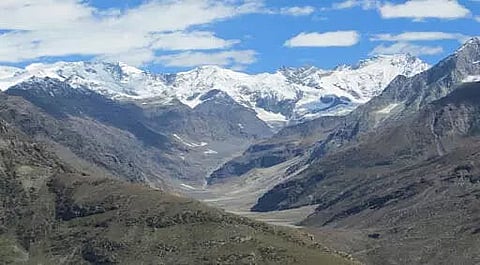
- Home
- Live Blog
- Breaking News
- Top Headlines
- Cities
- NE News
- Sentinel Media
- Sports
- Education
- Jobs

A CORRESPONDENT
HAFLONG: In an attempt to understand the potential of the Eastern Himalayas in providing a sustainable environment to the inhabitants along with their adaptation with climate change, the Department of Science & Technology, Government of India has funded an NMHSE Project entitled 'Climate Change and Sustainability of Agricultural Practices and Livelihood in the Eastern Himalayas: Case Studies in North Eastern Region in India'.
A team of five members led by principal investigator, Dr. RatulMahanta, Professor, Department of Economics, Gauhati University and co-principal investigator Dr. NityanandaDeka, Assistant Professor, Department of Geography, Gauhati University along with two M. Phil scholars of Department of Economics, MunmunGogoi and Saddam Hussain and a veterinarian, Dr. DimpiKhanikar, conducted a pilot survey in Umrangso and Haflong in Dima Hasao district.
The team upon their visit to villages of these regions found immense potential of horticulture and livestock rearing apart from mainstream agriculture. The traditional practice of pig rearing by the Dimasa community, a characteristic of this community has been a significant support to the families. ManuharKharikapsa, a local of the Dimahading village of Umrangso, is one such example who has been immensely profited by pig rearing. Also, he has very skillfully begun the plantation of areca nut and seasonal vegetables. The Nepali community in villages such as New Tunbung and Govindapur has over the years reared cattle as traditional component of their households. There is an immense potential of developing a dairy cooperative by the villagers. A small scale dairy farmer, Kirti Prasad Sarma, has had a sustainable livelihood through selling of milk and milk products for quite a long time. The team suggested that there is an urgent need of these farmers is proper market connectivity and efficient impartment of skills for preparation of value added products.
The team was also acquainted with the sericulture practice of Haflong. The ethnic practice of extraction of thread and weaving clothes in their households was highly appreciated by the team. Villages such as Lungkhok were visited by the team, to gauge the scope and potential for a booming sericulture and weaving industry by involving the local village women. The team interacted with RupaliHafila, an enthusiastic young lady of Lungkhok village who after completion of a training on rearing of silkworm and processing for thread, managed to awake the interest of the villagers towards sericulture in commercial scale. The plantation grounds for the Keseru, Mulberry, Castor, Soam trees and the machine operated processing section of the Sericulture department were visited by the team.
Here it is important to mention that an area of 30 bigha land of this village has been in operation for plantations of Keseru, Castor, Soam trees and this area has been successfully managed by these villagers. The team urged that this type of success story of sericulture practices should be expanded to other areas too which will be beneficial for all stakeholders of the ecology. It is the high time for the authority to motivate villagers to go for environment sustainable livelihood practices which not only enhance villager's standard of living but also protect the environment.
Also Watch: 4,500 Minority Community People Join BJP